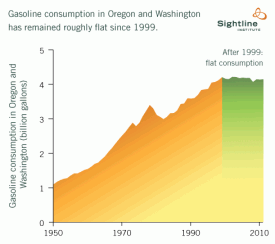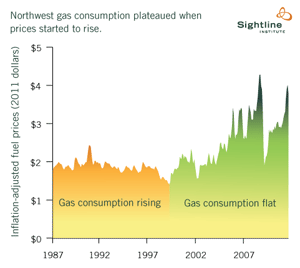I’ve been tracking gasoline consumption in the Northwest for over a decade now. But for most of that time I’ve been focused on the year-to-year ticks: a mini-surge in 2002 and 2003, a dip in 2008 when oil prices spiked, a rebound the following year when prices fell.
But the year-to-year fluctuations concealed a much bigger and more interesting story: gasoline consumption in Washington and Oregon has remained essentially flat since 1999. I describe the trends in our brand-new report: Peak Gas?: Northwest gasoline consumption stalled out in 1999.
 Take a look at the chart. Prior to 1999, gasoline consumption in the region grew steadily, roughly in step with the region’s growing population and burgeoning economy. The only substantial interruption in the meteoric rise in gas consumption was the economic downturn of the early 1980s.
Take a look at the chart. Prior to 1999, gasoline consumption in the region grew steadily, roughly in step with the region’s growing population and burgeoning economy. The only substantial interruption in the meteoric rise in gas consumption was the economic downturn of the early 1980s.
But since 2000, Oregon and Washington have grown substantially—in population, in average income, and in overall economic output. Yet total fuel consumption has barely budged.
This is not—I repeat, NOT—merely a result of recent economic doldrums. It can’t be: you can’t explain a trend that began all the way back in 1999 by referring to what’s happened in the last few years. Gas consumption stalled out well before the economic crisis in 2008. It stalled before oil prices spiked to record highs; before the military actions in the Middle East in the last decade; and even before the turmoil following the 2001 terrorist attacks. Arguably, it coincides with the beginning of the previous recession, triggered by the dot.com bust of 2000.
The biggest single reason why gas consumption halted its seemingly inexorable rise is pretty obvious: gas prices.
As of the late 1990s, a gallon of gas was at its all-time, inflation-adjusted low; and prices had been fairly stable for well over a decade. I’m old enough to remember when pundits argued that oil’s trajectory proved that commodity prices would always fall, if governments just got out of the way and let markets and human ingenuity run free. (Chortle.)
But the ink had barely dried on the pundits’ prognostications when gas prices started to buck the predictions: first rising, then spiking wildly. And it’s clear that prices have gradually focused Northwesterners’ attention on ways to cut back on gas consumption. Bit by bit, our travel habits changed: we bought fewer gas guzzlers, we looked for ways to trim back on car travel, we adjusted to price spikes by driving less and taking transit more. And families with access to more than one vehicle are often opting for the more efficient one.
There are other reasons why gas consumption has flattened out: population and demographic growth slowed in the 2000s, compared with previous decades; economic uncertainty has made it harder for some folks to afford to drive; the enormous “baby boom” generation is aging past its peak middle-age driving years, and being replaced by the much smaller “baby bust” generation; land use shifts have brought more people closer to compact city and town centers; some urban roads have reached their maximum capacities. And so on. Many of these same trends are affecting gas consumption throughout the US, but the flat-lining of consumption began earlier in the Northwest than in many parts of the country.
Regardless of the reasons, in many ways it’s good news that the region’s gasoline consumption has stopped growing. Washington and Oregon don’t produce a single drop of petroleum—we have to import everything we use from other parts of the US or the world. And we pay an awful lot for the oil we burn; if oil prices stay high, the two states combined could spend over $21 billion for oil this year. Think of the benefits to the economy if we could keep a few billion of those dollars here at home, circulating among local businesses and residents, rather than shipping them out to fuel our petroleum addiction!!
As the investment industry is always pointing out, past performance is no guarantee of future results. Perhaps fuel prices will fall, and the Northwest’s gas consumption will start to inch upwards once again.
Yet if recent price movements are any guide, our economy remains strapped into the roller coaster of high and volatile gas prices. If that roller coaster ride continues, it’s likely that gas consumption will remain flat. Many analysts, including the forecasters at the Washington State Office of Financial Management, even predict a decline in consumption. Nationally, new fuel economy standards are making our cars more efficient; as individuals, we’ll continue to look for ways, big and small, to cut back on fuel consumption; and as a region, we may never return to the gas guzzling trends of the past.



Comments are closed.